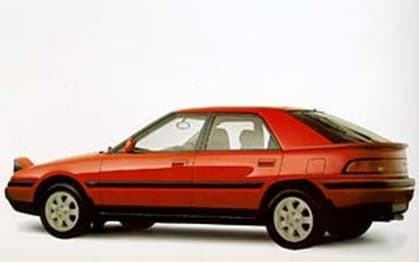
Mazda 323 Lantis 1993 Review
- Mazda 323
- Mazda 323 1993
- Mazda 323 Reviews
- Mazda Reviews
- Mazda Hatchback Range
- Mazda Sedan Range
- Hatchback
- Sedan
- Mazda

A brief test drive at the Japan Automobile Research Institute test track near Tokyo confirmed the car has the engineering and dynamics to make it one of Australia's most popular driver's cars. Mazda calls it the Lantis.
Styling is bold, incorporating the best elements of Mazda's dream run of great-looking cars including the MX-5, MX-6, 626 and Eunos 30X (MX-3 in some markets).
When you hop into the hatch or sedan, you immediately notice the extra space. It comes from a 105mm increase in the wheelbase and shorter overhangs, particularly at the rear for the hatch.
But the big revelation comes when you switch on the ignition and put your foot on the accelerator. The test cars were all powered by Mazda's potent 2.0 litre 24-valve V6 with a healthy 125kW power at 7000rpm and 180Nm of torque at 5500rpm.
When the cars come to Australia, Mazda will also offer the current 1.8-litre 16-valve four-cylinder engine with power lifted 8kW to 100kW at 7000rpm and torque up 5Nm to 160Nm at 4500rpm. Mazda is also likely to retain its price-leading 1.6-litre engine.
But the V6, essentially the unit from the Eunos 500, is the engine that people will talk about. It provides scintillating performance when matched to the lighter body of the 323. Acceleration is impressive from this willing engine. Top speed in Japan is electronically limited to 180kmh, a speed quickly reached by the manual hatch and achievable with the automatic.
Japanese cars usually have a softer suspension than the cars sent to Australia, but the Lantis/323 gives no hint of its more supple settings. The suspension arms have been extended to avoid big changes to the geometry, and the front dampers include built-in rebounding springs for stability and drive comfort.
For the V6, 16-inch alloy wheels with low-profile 50-series tyres provide the strong grip required by this level of performance. On-road agility is appreciably better than the current 323 models, and cornering is precise with improved feel to the steering.
Mazda has upgraded the car's body rigidity which, combined with the light weight and short overhangs, produces sure handling with minimal noise and vibration. Disc brakes all-around are standard while anti-lock brakes, driver's and front passenger's airbags, and a glass sunroof are optional.
Although the V6 version will not be cheap when it arrives in Australia, it will provide an alternative for those whose budget does not quite stretch to the V6powered 626.
Pricing guides
Range and Specs
| Vehicle | Specs | Price* | |
|---|---|---|---|
| (base) | 1.6L, ULP, 3 SP AUTO | $2,090 – 3,300 | 1993 Mazda 323 1993 (base) Pricing and Specs |
| Astina | 1.8L, ULP, 4 SP AUTO | $2,310 – 3,630 | 1993 Mazda 323 1993 Astina Pricing and Specs |
| Astina SP | 1.8L, ULP, 5 SP MAN | $2,640 – 4,070 | 1993 Mazda 323 1993 Astina SP Pricing and Specs |
$1,980
Lowest price, based on third party pricing data







